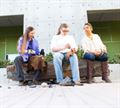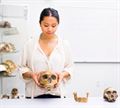
 With a growing collection of artifacts and replicas, UC Merced’s anthropology teaching laboratory gives students the ability to hold history in their hands.
With a growing collection of artifacts and replicas, UC Merced’s anthropology teaching laboratory gives students the ability to hold history in their hands.
Students taking anthropology courses are able to study replica casts from Australopithecus, Neanderthal and other human ancestors. They can also look at pottery fragments, tools and projectile points from San Bernardino County and Modoc National Forest.
Holding and examining artifacts, even if they are replicas, adds a powerful element to classes in anthropology and archaeology that goes beyond what a textbook can show.
“I get a surge of excitement every time I get to touch an artifact,” senior Althea Asaro said. “I feel connected to the past in a more real way than I get from looking at pictures in books.”
Handling crafted items creates a link with a person from another time, said third-year anthropology student Troy Zaffuts-Tournat.
“It’s an eye-opening experience — holding things that someone long ago created and used,” Zaffuts-Tournat said.
For Professor Kathleen Hull, the lab lends a sense of wonder to the subject while also helping teach investigative techniques. The laboratory also seeks to produce data that can be given to the museums and agencies that have donated or loaned items to UC Merced.
Students examine tools crafted by native people in what is the state’s far northeastern corner — from Modoc National Forest.
“It’s a win-win situation for them and for us,” Hull said. “Our students get hands-on training in analysis methods. The Modoc National Forest gets data back for their management activities.”
The San Bernardino County Museum donated a collection of pottery fragments and stone tools from the Southern California desert. Many of the pieces have limited scientific value because their places of origin are not documented. But for teaching, they’re invaluable, Hull said.
 The lab will be used for undergraduate courses in anthropology and archaeology, though it can be used for more specialized classes. For anthropology Professor Christina Torres-Rouff, the lab was perfect for a course on the bioanthropology of inequality.
The lab will be used for undergraduate courses in anthropology and archaeology, though it can be used for more specialized classes. For anthropology Professor Christina Torres-Rouff, the lab was perfect for a course on the bioanthropology of inequality.
Those students looked at clues to social status found in human remains, which in the case of the lab are replicas.
In the lab, the students could see the tangible effects of malnutrition, including shorter and weaker bones, worn teeth and deformed spines.
“It definitely made the subject matter of the course more alive,” Torres-Rouff said.
At about 750 square feet, the lab is suited to groups of less than 20 students. As the collection grows, graduate students may find interesting objects from the collection to work with there, Hull said.
The lab is also helping younger students get a feel for the past. Earlier this year, Hull brought objects from the lab to a girls’ science camp sponsored by the American Association of University Women.
Whatever their age, students who visit almost always leave with a powerful and enduring impression, Hull said.
“I think it has an emotional impact for students,” Hull said. “They feel a sense of awe that someone held and used this thing in daily living.”






